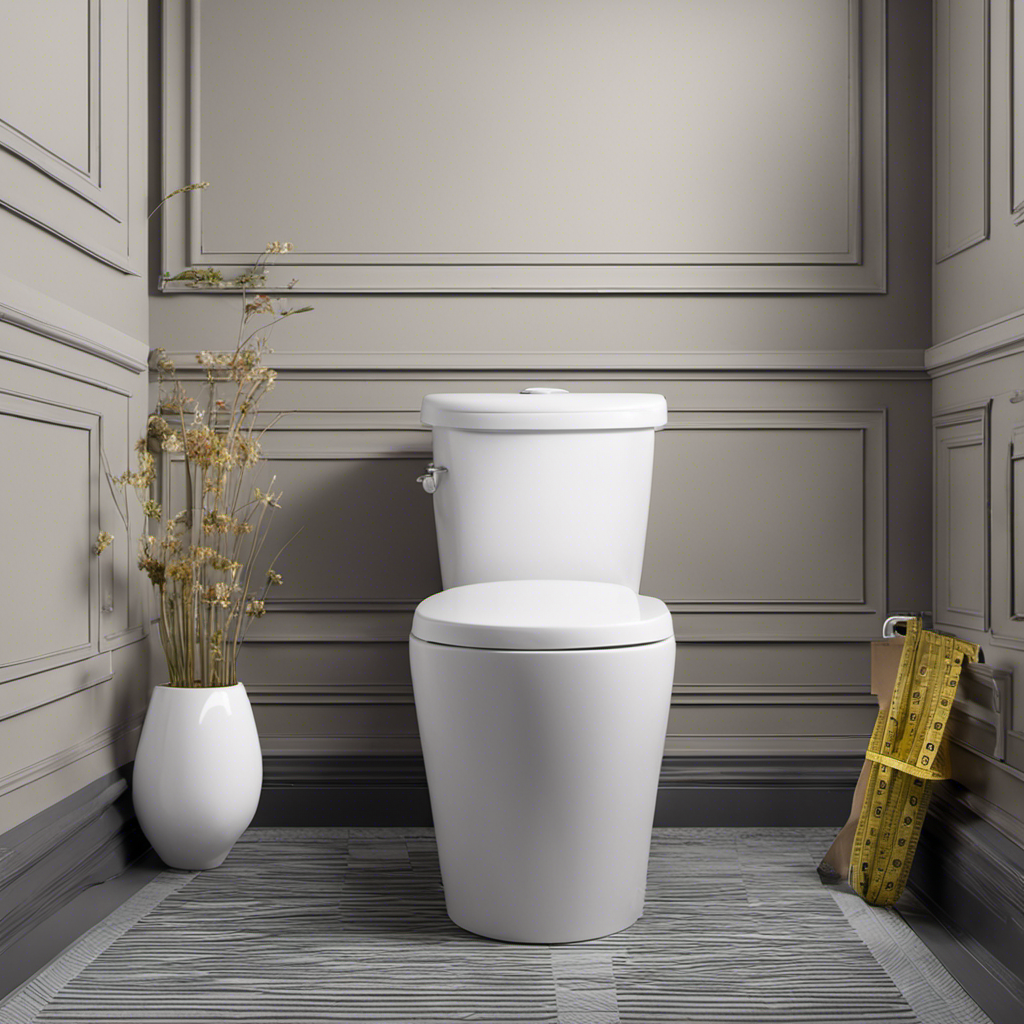As a homeowner, understanding the rough in size of a toilet is crucial when it comes to bathroom renovations. Picture this: you’ve just purchased a new toilet, only to find out it doesn’t fit in your existing plumbing system. Frustrating, right? That’s where knowing the rough in size comes into play.
In this article, I will guide you through the ins and outs of rough in size for toilets, including how to measure it, adjust existing plumbing, and choose the right toilet based on this critical measurement.
Let’s dive in.
Key Takeaways
- Rough in size refers to the distance between the wall and the center of the drainpipe.
- The most common rough in size for toilets is 12 inches.
- Accurate measurement of rough in size is crucial for proper toilet fit.
- Professional assistance is important for accurate measurements and troubleshooting rough-in size issues.
Common Rough in Sizes for Toilets
If you’re looking to install a new toilet, it’s important to know the common rough in sizes. The rough in size refers to the distance between the wall behind the toilet and the center of the drainpipe. This measurement is crucial because it determines whether or not the toilet will fit properly in your bathroom.
To measure the rough in accurately, start by locating the center of the drainpipe and then measure from there to the wall. The most common rough in sizes are 10, 12, and 14 inches.
However, if you encounter any issues with the rough in size, such as it being too short or too long, there are solutions available. Troubleshooting rough in issues may involve adjusting the drainpipe, using an offset toilet flange, or even relocating the toilet altogether.
How to Measure Rough in Size for a Toilet
Accurate measurements are crucial when it comes to installing a toilet. Knowing the common rough in sizes and how to measure them properly is essential for ensuring a proper fit.
However, in some cases, you may encounter non-standard sizes, requiring adjustments to be made to accommodate the toilet.
Importance of Accurate Measurements
To ensure proper installation, you’ll need to take precise measurements of the rough-in size for your toilet. Accurate measurements are crucial for a successful installation and to avoid any potential issues down the line. Here are some key reasons why accurate measurements are important:
-
Proper alignment: Accurate measurements ensure that the toilet aligns perfectly with the existing plumbing, preventing any leaks or misalignments.
-
Efficient use of space: Precise measurements allow for maximum utilization of available space, especially in small bathrooms, ensuring the toilet fits seamlessly without any obstructions.
-
Stability and durability: Accurate measurements ensure that the toilet is securely anchored to the floor, providing stability and preventing any wobbling or damage over time.
-
Easy troubleshooting: Accurate measurements make troubleshooting any rough-in size issues easier, as you can identify and address any discrepancies before installation.
-
Cost-effective: Taking accurate measurements upfront saves you time, money, and frustration by avoiding the need for costly adjustments or replacements later on.
Common Rough in Sizes
Taking precise measurements of the rough-in sizes is essential for proper toilet installation and ensuring a seamless fit without any obstructions. When measuring the rough in accurately, it is important to be knowledgeable about the common toilet rough in sizes.
The most common rough in size is 12 inches, which refers to the distance between the wall and the center of the toilet flange. This size is commonly found in residential homes. However, there are also toilets with a rough in size of 10 or 14 inches. These sizes are less common but may be necessary in certain situations, such as older homes or when replacing existing toilets.
Adjusting for Non-Standard Sizes
When dealing with non-standard sizes, it’s important to make the necessary adjustments for a proper fit during toilet installation. Here are some key steps to troubleshoot and adjust for irregular sizes:
-
Measurements: Take precise measurements of the rough-in size, which is the distance from the wall to the center of the toilet flange. This will help determine the adjustments needed.
-
Offset Flanges: Consider using an offset flange to shift the toilet bowl to the desired position if the rough-in size is slightly off.
-
Extender Kits: If the rough-in size is too short, an extender kit can be used to bridge the gap between the flange and the toilet bowl.
-
Custom Fabrication: In extreme cases, custom fabrication may be required to create a toilet base that fits the non-standard rough-in size.
-
Professional Help: When in doubt, seek the assistance of a professional plumber who can provide expert guidance and ensure a proper fit.
Understanding the Importance of Rough in Size
Understanding the importance of rough in size is crucial for ensuring that your toilet fits properly in your bathroom.
When it comes to installing a toilet, the rough in size refers to the distance between the wall behind the toilet and the center of the drainpipe. It is essential to measure this distance accurately before purchasing a new toilet to avoid any installation issues.
To measure the rough in size, use a measuring tape and start from the wall to the center of the drainpipe. If you encounter any difficulties or discrepancies in the measurements, there are troubleshooting tips available.
For instance, if the rough in size is too small, you may need to adjust the position of the drainpipe or consider using a smaller toilet. Conversely, if the rough in size is too large, you can use a spacer to fill the gap.
Adjusting the Rough in Size for Existing Plumbing
When it comes to adjusting the rough in size for existing plumbing, there are a few key considerations to keep in mind.
As a professional in the field, I have dealt with various situations where changing plumbing and modifying toilet placement were necessary. Here are some important points to consider:
-
Assessing the existing plumbing: Before making any changes, it’s crucial to thoroughly evaluate the current plumbing setup. This includes examining the location and size of the drain pipe, water supply lines, and venting system.
-
Determining the required rough in size: Based on the assessment, the rough in size needs to be determined. This refers to the distance from the finished wall to the center of the drainpipe.
-
Modifying the drainpipe: In some cases, the drainpipe may need to be adjusted or relocated to accommodate the desired toilet placement.
-
Repositioning water supply lines: If the toilet is being moved, the water supply lines may need to be repositioned accordingly.
-
Considering the venting system: Modifying the toilet placement may also require adjustments to the venting system to ensure proper air circulation and prevent plumbing issues.
Choosing the Right Toilet Based on Rough in Size
When it comes to installing a toilet, the rough-in is a critical aspect that should not be overlooked. The rough-in refers to the distance between the center of the toilet’s flange and the finished wall.
It is important to measure the rough-in correctly as it determines the size and compatibility of the toilet with your plumbing system.
Importance of Rough-In
The rough-in size of a toilet is crucial for ensuring proper installation. It determines the distance between the wall and the center of the toilet flange, which affects the alignment and functionality of the toilet. The importance of proper installation cannot be overstated, as an incorrect rough-in size can lead to various consequences.
Misalignment: A toilet with an incorrect rough-in size may not align properly with the plumbing connections, causing leaks or blockages.
Unstable mounting: Incorrect rough-in size can result in an unstable toilet that wobbles or shifts when in use.
Limited space: If the rough-in size is too small, there may not be enough space for the toilet to fit properly, leading to discomfort or difficulty in using the bathroom.
Damage to flooring: Improperly sized rough-in can cause damage to the flooring around the toilet due to leaks or excessive pressure.
Costly repairs: Fixing a toilet with an incorrect rough-in size may require extensive plumbing work, leading to additional expenses.
To avoid these issues, it is crucial to measure the rough-in correctly, as I will explain in the next section.
Measuring Rough-In Correctly
Measuring the rough-in correctly ensures proper installation and prevents potential issues. When it comes to toilets, the rough-in refers to the distance between the wall behind the toilet and the center of the sewer drainpipe. Accurate measurements are crucial to ensure that the toilet fits perfectly and functions properly.
To measure the rough-in, you will need a tape measure. Start by locating the center of the sewer drainpipe and measure from there to the wall behind the toilet. The most common mistake people make is not measuring accurately, which can result in a toilet that doesn’t fit properly or one that leaks.
Another common mistake is assuming that all toilets have the same rough-in size, which is not the case. So, it’s always best to measure carefully to avoid any installation problems.
Troubleshooting Rough in Size Issues With Toilets
If you’re having trouble with the rough in size of your toilet, there are a few troubleshooting steps you can take.
First, check if the rough in size is standard or non-standard. If it’s non-standard, you may need to adjust the toilet to fit properly.
Here are some steps to help you troubleshoot rough in size issues and adjust for non-standard sizes:
- Measure the rough in size accurately using a tape measure.
- Check if the toilet flange is properly aligned and level.
- Adjust the toilet flange height if necessary using shims or spacers.
- Consider using offset flanges or offset toilet connectors for extreme rough in size differences.
- Consult a professional plumber if you’re unsure or if the issue persists.
Conclusion
In conclusion, understanding the rough in size for a toilet is crucial when it comes to installation and compatibility with existing plumbing. By accurately measuring the rough in size, homeowners can ensure a seamless fit and avoid any costly adjustments.
Choosing the right toilet based on rough in size is essential for a functional and efficient bathroom. So, don’t underestimate the importance of this measurement!
It’s like finding the perfect puzzle piece that completes the picture of your dream bathroom, making it a match made in plumbing heaven.










